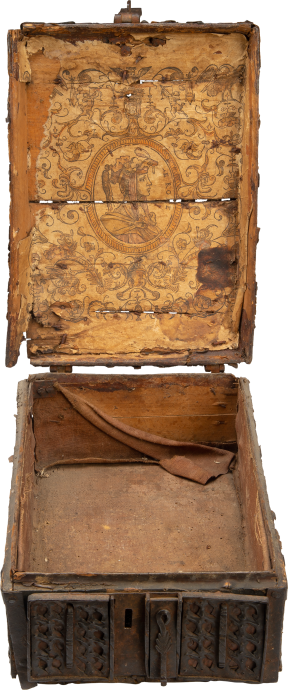


Woodcut of “Erope” surrounded by Grotesques
, mid 15th c.

Woodcut of “Erope” surrounded by Grotesques
Description
Distinctive from late-medieval varieties, this Renaissance coffret is an extremely rare object containing a one-of-a-kind print. Inspired by works produced in the famed Galerie François at the chateau of Fontainebleau, the impression personifies the continent of Europe as a young woman wearing an elaborate headdress surrounded by an intricate field of grotesques and foliage. It was once part of the largest single collection of Gothic coffrets formed by André and Marie-Thérèse Jammes (no. 29), which was sold in 2007. It belongs to a series of coffret prints depicting the four continents (Europe, Africa, Asia, and America) and the deities of antiquity. Only three other impressions of this series are known: Africa personified as “La Sovage” (Allen Memorial Art Museum, Oberlin College, no. 2016.5; formerly Jammes no. 30) (fig. 1); “Hercules” (Bibliothèque nationale de France, Départment des Estampes et de la Photographie, Musee OBJ-389-PT FT; formerly Jammes no. 31); and “Juno” (Private Collection; formerly Jammes no. 32) (fig. 2).
Research by Severine Lepape has shown that coffrets continued to be produced well after their initial popularity in the decades around 1500 (Lepape 2019, 66-67). However, few of these later sixteenth-century examples have survived. Prints from these coffrets reflect the latest vogues in Renaissance France. This impression of Erope draws heavily on images of masked women attributed to Leonard Thiry, now preserved in Paris at the École nationale supérieure des beaux-arts (Brugerolles 1994). Thiry was a Flemish painter and draughtsman, active in France between 1530 and 1550 who worked as Rosso Fiorentino’s assistant in the Galerie François I at the chateau of Fontainebleau. Thiry’s drawings were translated into engravings by Pierre Milan around 1535-1545 from which the medallion image of Erope takes inspiration (Baselitz et al 1994, nos. 76-79) (fig. 3).
Though inspired by atelier at the Galerie Francois, the coffret and print were likely produced in Lyon. The print was composed from two blocks. The impression of the central medallion of “Erope” is framed by a second block incised with an ornamental field of grotesques, birds, and flowers. These borders come from two sources: a 1557 edition of Ovid’s Metamorphosis illustrated by Bernard Salomon for the printer Jean de Tournes (Cartier 1937, figs. 5, 14; Brun 1969, pl. 22) (fig. 4) and an engraved series of saints and mythological heroes from by Martial de Bargues, an illuminator from Lyon (Lepape 2019, 67).
The construction of the coffret itself follows the typology of the late-Gothic Parisian boxes with iron fittings, sturdy hardware for the locking mechanism, and hoops for the straps. The boxes of the Continents (Europe and Africa) display small hooks—not present on the medieval boxes—that must have served to keep them open for display purposes.
The Jammes sale of 2007 inspired new research by Lepape, Sandra Hindman, and others on the typology and function of coffrets and their prints. A recent discovery of a Northern Renaissance painting of the Rest on the Flight, published by Hindman, reveals how coffrets were used. The painting includes a detail of a large, partially opened box containing a small leather-bound book with clasps, a rosary composed of precious gems, a brush, scissors, and two finger-rings all nest on diaphanous white cloth inside the box. This detail survives as the only known contemporary depiction of sixteenth-century coffrets.
Literature
Brugerolles, E. Le dessin en France au XVIe siècle: Dessins et miniatures des collections de l’École des beaux-arts, Paris, 1994, pp. 108-110, no. 37.
Linzeler, A. Inventaire du fonds français: Graveurs du XVIe siècle, vol. 1. Paris, 1932, pp. 179-182.
Pierre Bergé & Associes. Collection Marie-Thérèse et Andre Jammes: Coffrets de messagers, images du Moyen Age et traditions populaires, Paris, 2007, no. 29.
Robert-Dumesnil, A.-P.-F. Le peintre-graveur français ou catalogue raisonné des estampes gravées par les peintres et les dessinateurs de l’École Française, vol. 8. Paris, 1835-1871, no. 79.
On coffrets and Renaissance prints see:
Baselitz, G. et al. La gravure française à la Renaissance à la Bibliothèque nationale de France, Los Angeles, 1994.
Cartier, A. Bibliographie des éditions des de Tournes, imprimeurs lyonnais, Paris, 1937.
Brun, R. Le Livre français illustré de la Renaissance, étude suivie du Catalogue des principaux livres à figures du XVIe siècle, Paris, 1969.
Hindman, S. “Gothic Traveling Coffers Revisited,” in Le Livre, La Photographie, L’Image & La Lettre: Essays in Honor of André Jammes, ed. Sandra Hindman, Isabelle Jammes, Bruno Jammes and Hans P. Kraus Jr., Paris, 2015, pp. 312-327.
Huyhn, M. and S. Lepape. “De la rencontre d’une image et d’une boîte: Les coffrets à estampe,” La Revue des Musées de France, 4 (2011), pp. 37-50.
Huyhn, M. and S. Lepape. « De nouveaux témoignages iconographiques des coffrets à estampes » Nouvelles de l’estampe 256 (2016), pp. 4-19.
Lepape, S. “Du nationalism au surréalism: Une petite histoire de coffrets,” Bulletin du Bibliophile, 1 (2012), pp. 11-23.
Lepape, S. “When Assemblage Makes Sense: An Example of a Coffret à Estampe,” Art in Print, 2 (2012), pp. 9-14.
Lepape, S. et al. Mystérieux coffrets: Estampes au temps de La Dame à la licorne, Paris, 2019.